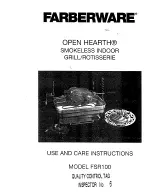
6
2.3
Operating modes
The operating mode of the unit is indicated by means of a code on the service display of
the operating panel.
-
Off
The unit is not in operation, but is connected to the electricity supply. No response is
given to requests for domestic hot water or CH water. The unit frost protection is active.
This means that the pump will start running and the exchanger will be heated up if the
temperature of the water in the system drops too far.
If the frost protection intervenes, the code
7
will be displayed (heating up exchanger).
The pressure in the CH installation can also be read from the temperature display in this
operating mode (in bar).
Standby
The LED at the key is lit and possibly one of the LEDs of the tap comfort function.
The unit is ready to respond to a request for CH or tap water.
Post-running CH
After the end of the CH operation, the pump will run for a specified time. The post-pumping
time is set to the value in par. 7.2 in its factory settings. This setting can be changed. In
addition to this, the pump will run automatically 1 time per 24 hours, for 10 seconds, in order
to prevent it from getting stuck. This automatic switching on of the pump takes place at the
time of the last heating request. In order to change this, the room thermostat needs to be set
higher for a moment, at the required time of day.
1
Requested temperature reached
The boiler controller may temporarily block the heat request. The boiler controller will
then be stopped. The block occurs because the required temperature has been
reached. When the temperature has sufficiently decreased, the block will be lifted.
2
Self test
Once every 24 hours, the boiler controller tests the connected sensors. During the test,
the controller will not carry out any other tasks.
3
Ventilating
When the unit is started, the fan is first brought up to its correct start rpm. When the
start rpm is reached, the boiler controller will be ignited. Code
3
is also visible when
there is post-fanning after the boiler controller is stopped.
4
Igniting
When the fan has reached the start rpm, the boiler controller will be ignited by means of
electrical sparks. During the ignition, code
4
is displayed. If the boiler controller does
not ignite, a new attempt will be made after approximately 15 seconds. If after 4 ignition
attempts, the boiler controller has still not been ignited, the controller will go into down-
time.
5
CH operation
An on/off thermostat, an OpenTherm thermostat, an outdoor sensor or a combination
thereof can be connected to the controller (see par. 10.1).
When there is a heat request from a thermostat, after the fan has started running (code 3),
the ignition will take place (code
4
) followed by the CH operating mode (code
5
).
During CH operating, the rpm of the fan and therefore the power of the unit can be
adjusted so the temperature of the CH water to the required CH supply temperature can
be controlled. If an on/off thermostat has been connected, this will be the CH supply
temperature set on the display. In case of an OpenTherm thermostat, the required CH
supply temperature is determined by the thermostat. In case of an outdoor sensor, the
required CH supply temperature is determined by the fuel line programmed in the boiler
controller. For the last two situations, the temperature set on the display is the
maximum.
During CH operation, the requested CH supply temperature will be displayed on the
operating panel.
The CH supply temperature can be set between 30 and 90°C (see par. 7.1). Caution:
for a low temperature system, a lower maximum setting may be required than the
standard setting of 80°C.
You can press the service button during CH operation to read the actual CH supply
temperature.
If the tap comfort function is switched on (see code
7
), an OpenTherm heating
request of less than 40 degrees will be generated.
















































